MBA402 Risk Assessment Report: Trading.com Company Analysis
VerifiedAdded on 2023/06/08
|13
|3029
|268
Report
AI Summary
This risk assessment report analyzes Trading.com, a share investment course provider, using the risk exposure calculator from a Harvard Business Review article. The report identifies pressure points related to rapid growth, entrepreneurial culture, and information management. Key findings highlight risks associated with Jospe Drake's (CEO) aggressive growth strategies, inexperienced staff, internal competition, resistance to bad news, transaction complexity, diagnostic performance gaps, and decentralized decision-making. The analysis emphasizes the 'dangerous triad' of pressure, opportunity, and rationalization that can lead to unethical behavior and financial misrepresentation within the company. The report concludes that Trading.com faces significant risks due to high-pressure environment and operational vulnerabilities.
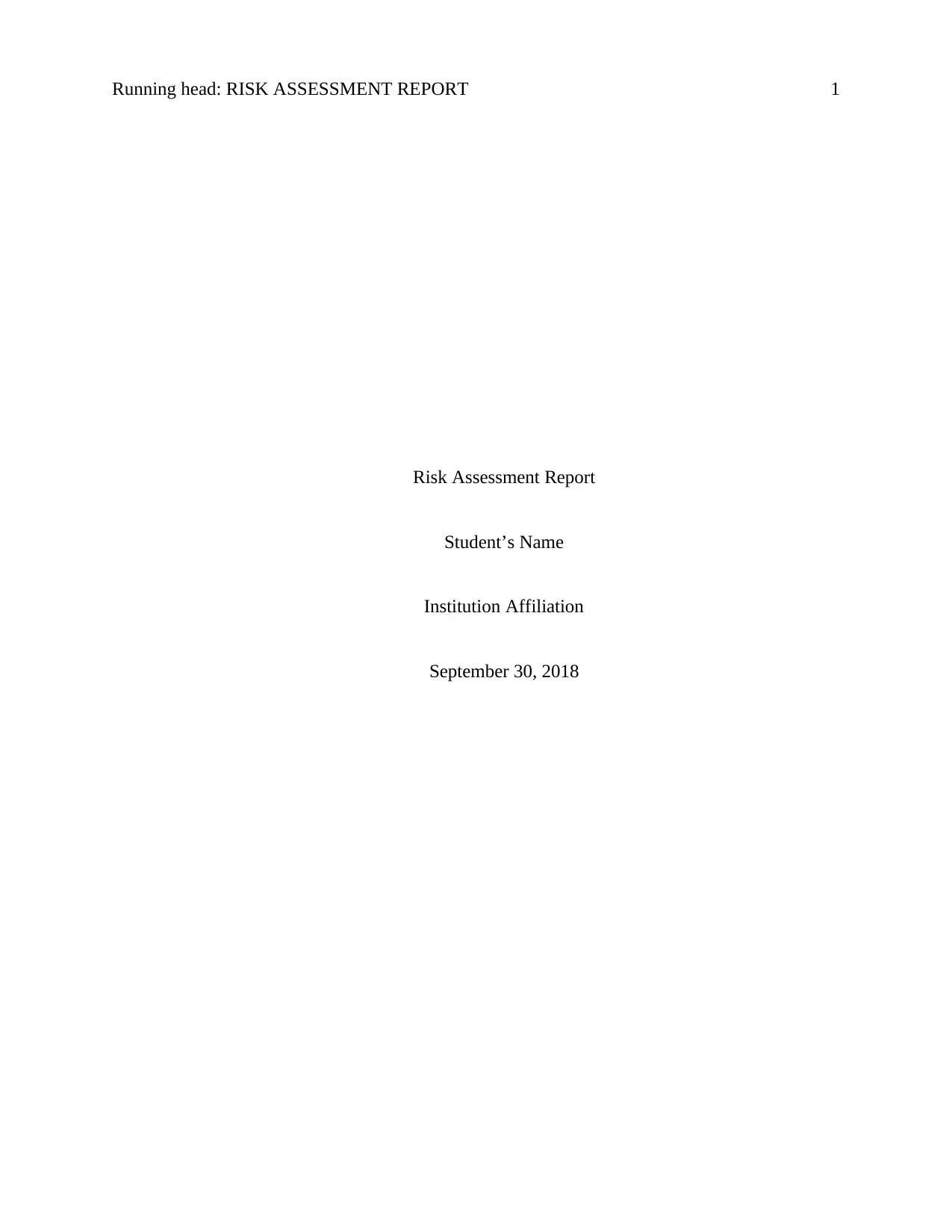
Running head: RISK ASSESSMENT REPORT 1
Risk Assessment Report
Student’s Name
Institution Affiliation
September 30, 2018
Risk Assessment Report
Student’s Name
Institution Affiliation
September 30, 2018
Secure Best Marks with AI Grader
Need help grading? Try our AI Grader for instant feedback on your assignments.
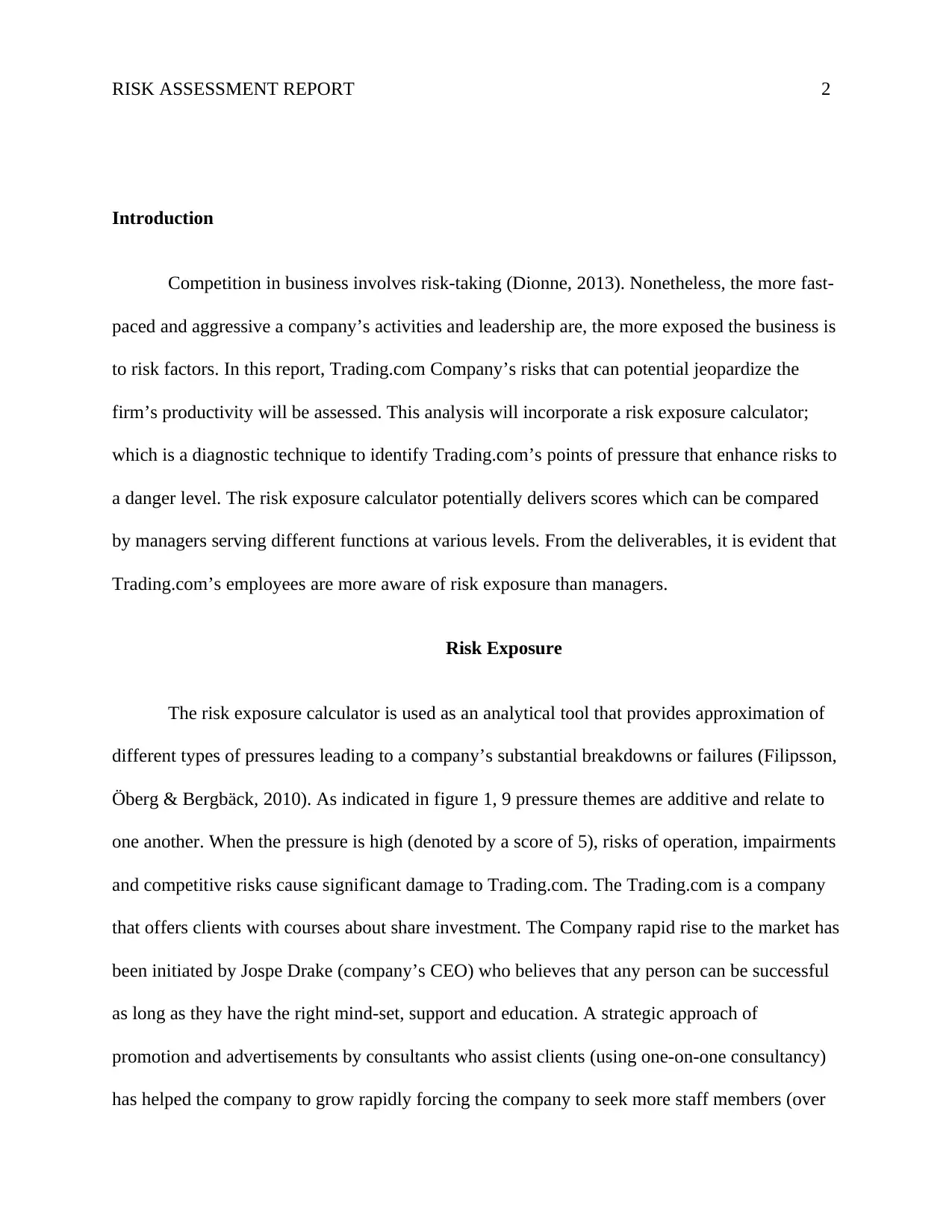
RISK ASSESSMENT REPORT 2
Introduction
Competition in business involves risk-taking (Dionne, 2013). Nonetheless, the more fast-
paced and aggressive a company’s activities and leadership are, the more exposed the business is
to risk factors. In this report, Trading.com Company’s risks that can potential jeopardize the
firm’s productivity will be assessed. This analysis will incorporate a risk exposure calculator;
which is a diagnostic technique to identify Trading.com’s points of pressure that enhance risks to
a danger level. The risk exposure calculator potentially delivers scores which can be compared
by managers serving different functions at various levels. From the deliverables, it is evident that
Trading.com’s employees are more aware of risk exposure than managers.
Risk Exposure
The risk exposure calculator is used as an analytical tool that provides approximation of
different types of pressures leading to a company’s substantial breakdowns or failures (Filipsson,
Öberg & Bergbäck, 2010). As indicated in figure 1, 9 pressure themes are additive and relate to
one another. When the pressure is high (denoted by a score of 5), risks of operation, impairments
and competitive risks cause significant damage to Trading.com. The Trading.com is a company
that offers clients with courses about share investment. The Company rapid rise to the market has
been initiated by Jospe Drake (company’s CEO) who believes that any person can be successful
as long as they have the right mind-set, support and education. A strategic approach of
promotion and advertisements by consultants who assist clients (using one-on-one consultancy)
has helped the company to grow rapidly forcing the company to seek more staff members (over
Introduction
Competition in business involves risk-taking (Dionne, 2013). Nonetheless, the more fast-
paced and aggressive a company’s activities and leadership are, the more exposed the business is
to risk factors. In this report, Trading.com Company’s risks that can potential jeopardize the
firm’s productivity will be assessed. This analysis will incorporate a risk exposure calculator;
which is a diagnostic technique to identify Trading.com’s points of pressure that enhance risks to
a danger level. The risk exposure calculator potentially delivers scores which can be compared
by managers serving different functions at various levels. From the deliverables, it is evident that
Trading.com’s employees are more aware of risk exposure than managers.
Risk Exposure
The risk exposure calculator is used as an analytical tool that provides approximation of
different types of pressures leading to a company’s substantial breakdowns or failures (Filipsson,
Öberg & Bergbäck, 2010). As indicated in figure 1, 9 pressure themes are additive and relate to
one another. When the pressure is high (denoted by a score of 5), risks of operation, impairments
and competitive risks cause significant damage to Trading.com. The Trading.com is a company
that offers clients with courses about share investment. The Company rapid rise to the market has
been initiated by Jospe Drake (company’s CEO) who believes that any person can be successful
as long as they have the right mind-set, support and education. A strategic approach of
promotion and advertisements by consultants who assist clients (using one-on-one consultancy)
has helped the company to grow rapidly forcing the company to seek more staff members (over
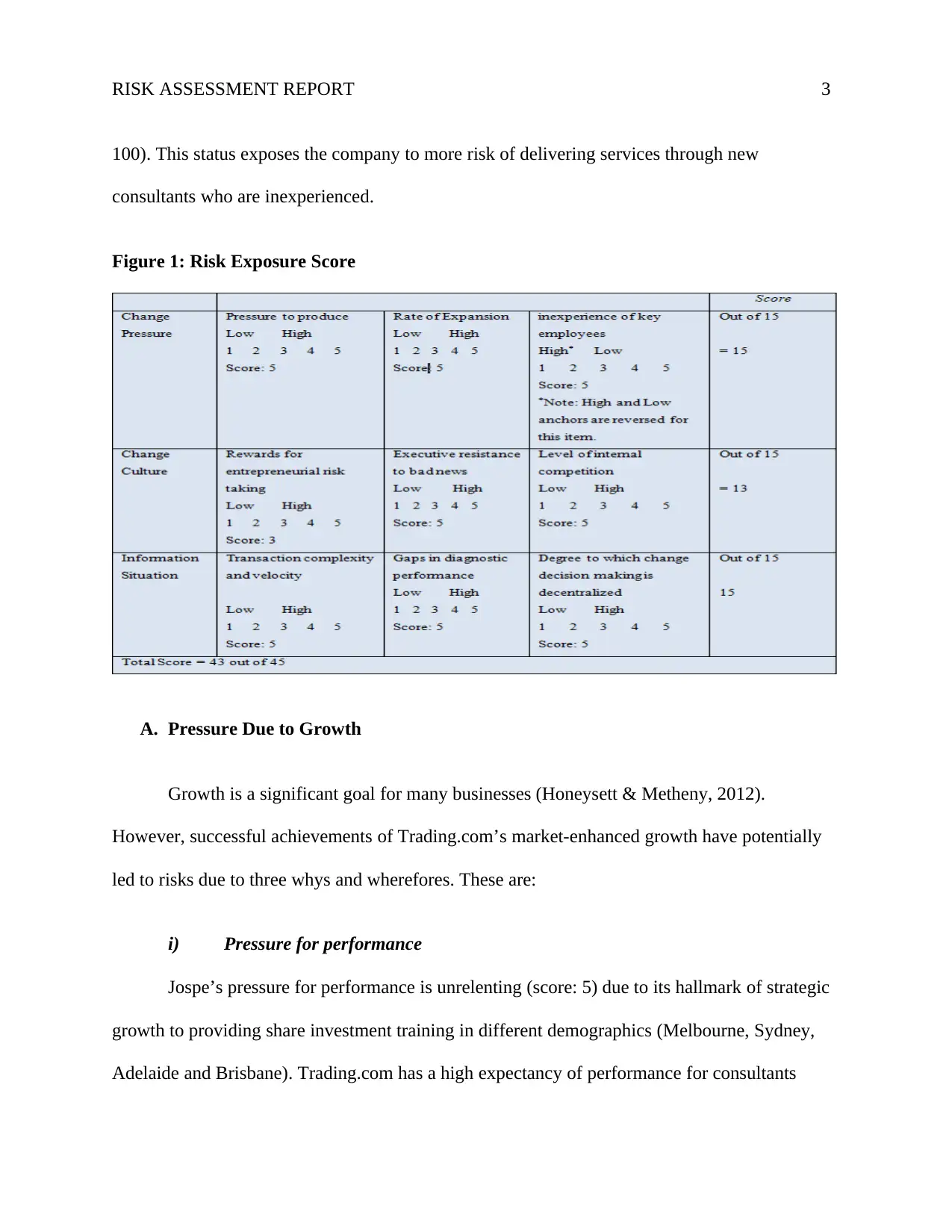
RISK ASSESSMENT REPORT 3
100). This status exposes the company to more risk of delivering services through new
consultants who are inexperienced.
Figure 1: Risk Exposure Score
A. Pressure Due to Growth
Growth is a significant goal for many businesses (Honeysett & Metheny, 2012).
However, successful achievements of Trading.com’s market-enhanced growth have potentially
led to risks due to three whys and wherefores. These are:
i) Pressure for performance
Jospe’s pressure for performance is unrelenting (score: 5) due to its hallmark of strategic
growth to providing share investment training in different demographics (Melbourne, Sydney,
Adelaide and Brisbane). Trading.com has a high expectancy of performance for consultants
100). This status exposes the company to more risk of delivering services through new
consultants who are inexperienced.
Figure 1: Risk Exposure Score
A. Pressure Due to Growth
Growth is a significant goal for many businesses (Honeysett & Metheny, 2012).
However, successful achievements of Trading.com’s market-enhanced growth have potentially
led to risks due to three whys and wherefores. These are:
i) Pressure for performance
Jospe’s pressure for performance is unrelenting (score: 5) due to its hallmark of strategic
growth to providing share investment training in different demographics (Melbourne, Sydney,
Adelaide and Brisbane). Trading.com has a high expectancy of performance for consultants
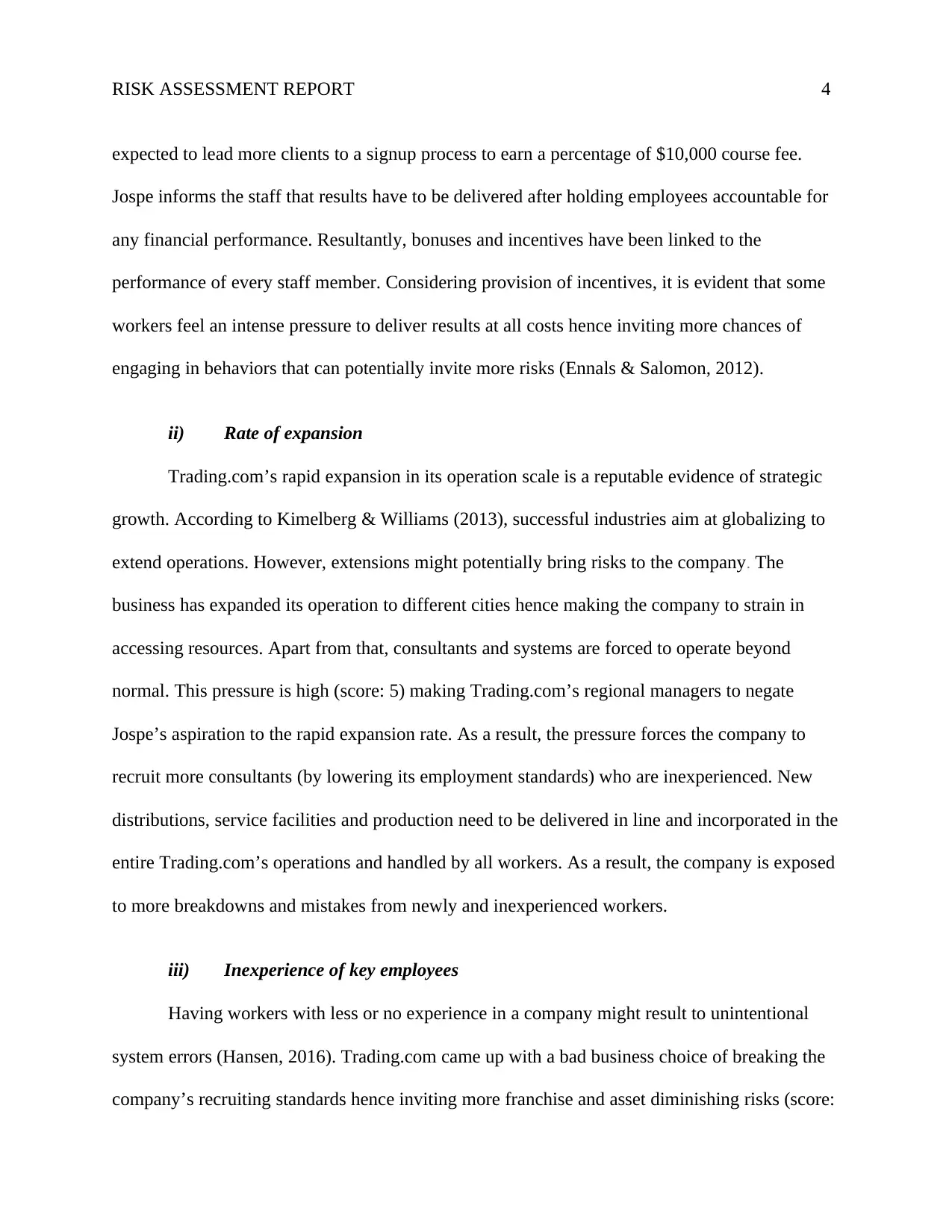
RISK ASSESSMENT REPORT 4
expected to lead more clients to a signup process to earn a percentage of $10,000 course fee.
Jospe informs the staff that results have to be delivered after holding employees accountable for
any financial performance. Resultantly, bonuses and incentives have been linked to the
performance of every staff member. Considering provision of incentives, it is evident that some
workers feel an intense pressure to deliver results at all costs hence inviting more chances of
engaging in behaviors that can potentially invite more risks (Ennals & Salomon, 2012).
ii) Rate of expansion
Trading.com’s rapid expansion in its operation scale is a reputable evidence of strategic
growth. According to Kimelberg & Williams (2013), successful industries aim at globalizing to
extend operations. However, extensions might potentially bring risks to the company. The
business has expanded its operation to different cities hence making the company to strain in
accessing resources. Apart from that, consultants and systems are forced to operate beyond
normal. This pressure is high (score: 5) making Trading.com’s regional managers to negate
Jospe’s aspiration to the rapid expansion rate. As a result, the pressure forces the company to
recruit more consultants (by lowering its employment standards) who are inexperienced. New
distributions, service facilities and production need to be delivered in line and incorporated in the
entire Trading.com’s operations and handled by all workers. As a result, the company is exposed
to more breakdowns and mistakes from newly and inexperienced workers.
iii) Inexperience of key employees
Having workers with less or no experience in a company might result to unintentional
system errors (Hansen, 2016). Trading.com came up with a bad business choice of breaking the
company’s recruiting standards hence inviting more franchise and asset diminishing risks (score:
expected to lead more clients to a signup process to earn a percentage of $10,000 course fee.
Jospe informs the staff that results have to be delivered after holding employees accountable for
any financial performance. Resultantly, bonuses and incentives have been linked to the
performance of every staff member. Considering provision of incentives, it is evident that some
workers feel an intense pressure to deliver results at all costs hence inviting more chances of
engaging in behaviors that can potentially invite more risks (Ennals & Salomon, 2012).
ii) Rate of expansion
Trading.com’s rapid expansion in its operation scale is a reputable evidence of strategic
growth. According to Kimelberg & Williams (2013), successful industries aim at globalizing to
extend operations. However, extensions might potentially bring risks to the company. The
business has expanded its operation to different cities hence making the company to strain in
accessing resources. Apart from that, consultants and systems are forced to operate beyond
normal. This pressure is high (score: 5) making Trading.com’s regional managers to negate
Jospe’s aspiration to the rapid expansion rate. As a result, the pressure forces the company to
recruit more consultants (by lowering its employment standards) who are inexperienced. New
distributions, service facilities and production need to be delivered in line and incorporated in the
entire Trading.com’s operations and handled by all workers. As a result, the company is exposed
to more breakdowns and mistakes from newly and inexperienced workers.
iii) Inexperience of key employees
Having workers with less or no experience in a company might result to unintentional
system errors (Hansen, 2016). Trading.com came up with a bad business choice of breaking the
company’s recruiting standards hence inviting more franchise and asset diminishing risks (score:
Secure Best Marks with AI Grader
Need help grading? Try our AI Grader for instant feedback on your assignments.
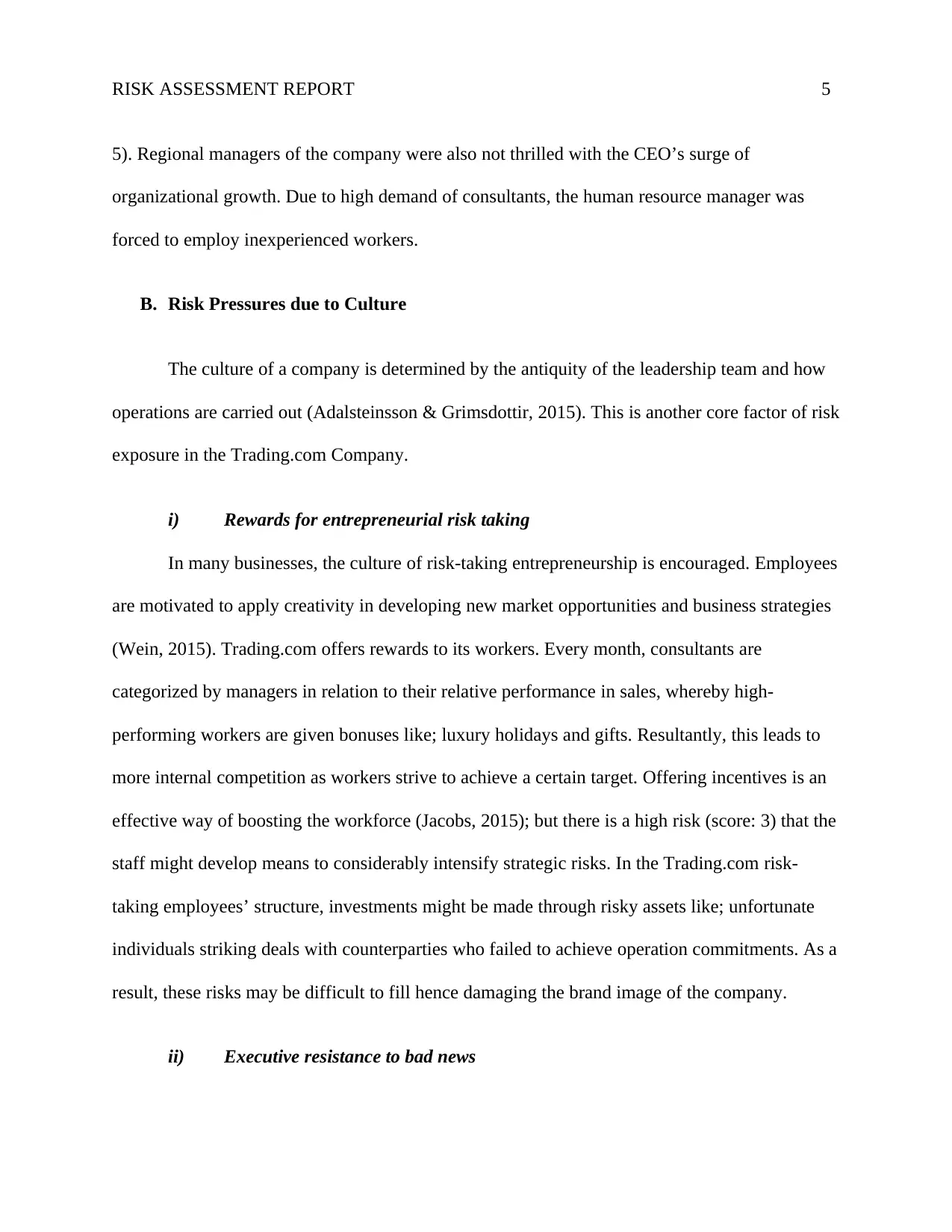
RISK ASSESSMENT REPORT 5
5). Regional managers of the company were also not thrilled with the CEO’s surge of
organizational growth. Due to high demand of consultants, the human resource manager was
forced to employ inexperienced workers.
B. Risk Pressures due to Culture
The culture of a company is determined by the antiquity of the leadership team and how
operations are carried out (Adalsteinsson & Grimsdottir, 2015). This is another core factor of risk
exposure in the Trading.com Company.
i) Rewards for entrepreneurial risk taking
In many businesses, the culture of risk-taking entrepreneurship is encouraged. Employees
are motivated to apply creativity in developing new market opportunities and business strategies
(Wein, 2015). Trading.com offers rewards to its workers. Every month, consultants are
categorized by managers in relation to their relative performance in sales, whereby high-
performing workers are given bonuses like; luxury holidays and gifts. Resultantly, this leads to
more internal competition as workers strive to achieve a certain target. Offering incentives is an
effective way of boosting the workforce (Jacobs, 2015); but there is a high risk (score: 3) that the
staff might develop means to considerably intensify strategic risks. In the Trading.com risk-
taking employees’ structure, investments might be made through risky assets like; unfortunate
individuals striking deals with counterparties who failed to achieve operation commitments. As a
result, these risks may be difficult to fill hence damaging the brand image of the company.
ii) Executive resistance to bad news
5). Regional managers of the company were also not thrilled with the CEO’s surge of
organizational growth. Due to high demand of consultants, the human resource manager was
forced to employ inexperienced workers.
B. Risk Pressures due to Culture
The culture of a company is determined by the antiquity of the leadership team and how
operations are carried out (Adalsteinsson & Grimsdottir, 2015). This is another core factor of risk
exposure in the Trading.com Company.
i) Rewards for entrepreneurial risk taking
In many businesses, the culture of risk-taking entrepreneurship is encouraged. Employees
are motivated to apply creativity in developing new market opportunities and business strategies
(Wein, 2015). Trading.com offers rewards to its workers. Every month, consultants are
categorized by managers in relation to their relative performance in sales, whereby high-
performing workers are given bonuses like; luxury holidays and gifts. Resultantly, this leads to
more internal competition as workers strive to achieve a certain target. Offering incentives is an
effective way of boosting the workforce (Jacobs, 2015); but there is a high risk (score: 3) that the
staff might develop means to considerably intensify strategic risks. In the Trading.com risk-
taking employees’ structure, investments might be made through risky assets like; unfortunate
individuals striking deals with counterparties who failed to achieve operation commitments. As a
result, these risks may be difficult to fill hence damaging the brand image of the company.
ii) Executive resistance to bad news
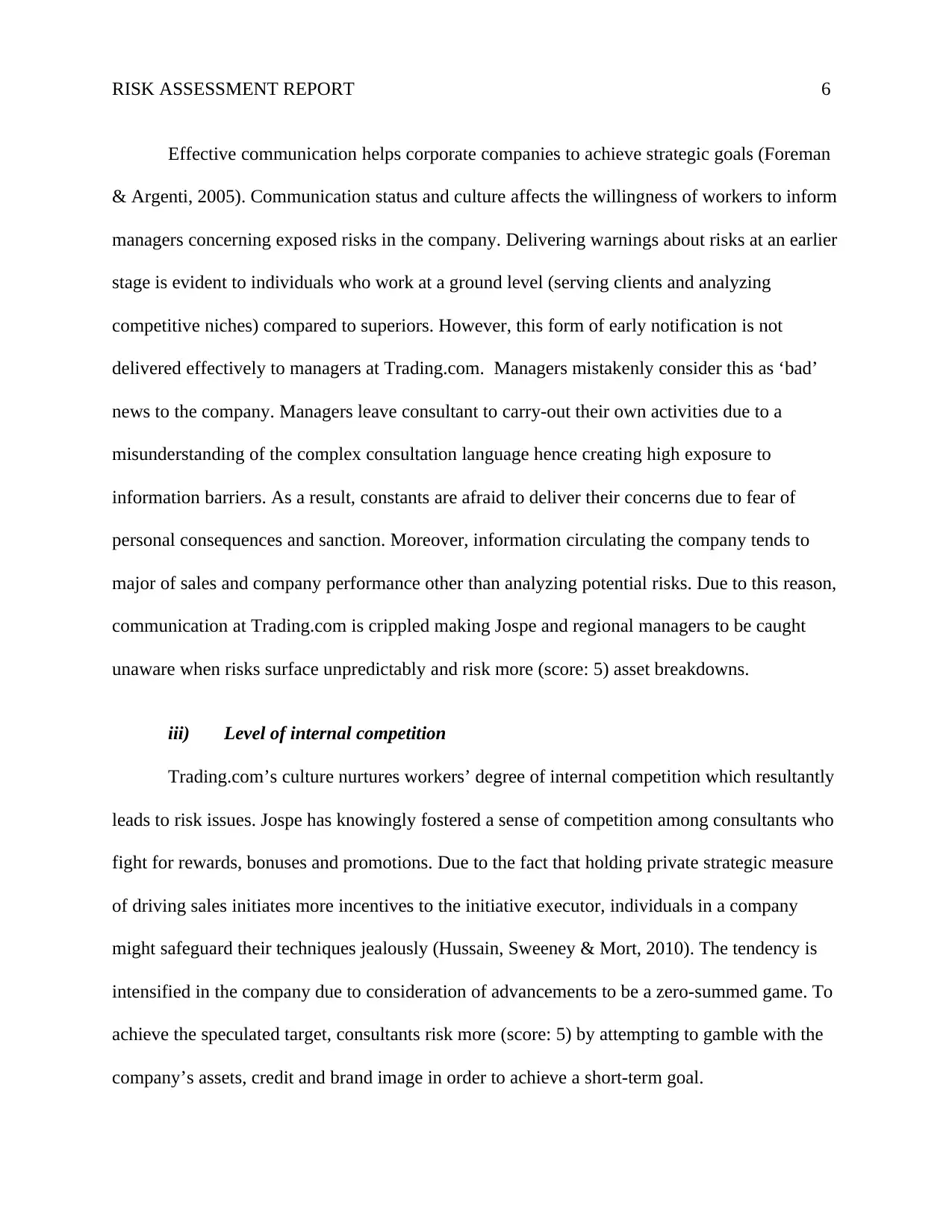
RISK ASSESSMENT REPORT 6
Effective communication helps corporate companies to achieve strategic goals (Foreman
& Argenti, 2005). Communication status and culture affects the willingness of workers to inform
managers concerning exposed risks in the company. Delivering warnings about risks at an earlier
stage is evident to individuals who work at a ground level (serving clients and analyzing
competitive niches) compared to superiors. However, this form of early notification is not
delivered effectively to managers at Trading.com. Managers mistakenly consider this as ‘bad’
news to the company. Managers leave consultant to carry-out their own activities due to a
misunderstanding of the complex consultation language hence creating high exposure to
information barriers. As a result, constants are afraid to deliver their concerns due to fear of
personal consequences and sanction. Moreover, information circulating the company tends to
major of sales and company performance other than analyzing potential risks. Due to this reason,
communication at Trading.com is crippled making Jospe and regional managers to be caught
unaware when risks surface unpredictably and risk more (score: 5) asset breakdowns.
iii) Level of internal competition
Trading.com’s culture nurtures workers’ degree of internal competition which resultantly
leads to risk issues. Jospe has knowingly fostered a sense of competition among consultants who
fight for rewards, bonuses and promotions. Due to the fact that holding private strategic measure
of driving sales initiates more incentives to the initiative executor, individuals in a company
might safeguard their techniques jealously (Hussain, Sweeney & Mort, 2010). The tendency is
intensified in the company due to consideration of advancements to be a zero-summed game. To
achieve the speculated target, consultants risk more (score: 5) by attempting to gamble with the
company’s assets, credit and brand image in order to achieve a short-term goal.
Effective communication helps corporate companies to achieve strategic goals (Foreman
& Argenti, 2005). Communication status and culture affects the willingness of workers to inform
managers concerning exposed risks in the company. Delivering warnings about risks at an earlier
stage is evident to individuals who work at a ground level (serving clients and analyzing
competitive niches) compared to superiors. However, this form of early notification is not
delivered effectively to managers at Trading.com. Managers mistakenly consider this as ‘bad’
news to the company. Managers leave consultant to carry-out their own activities due to a
misunderstanding of the complex consultation language hence creating high exposure to
information barriers. As a result, constants are afraid to deliver their concerns due to fear of
personal consequences and sanction. Moreover, information circulating the company tends to
major of sales and company performance other than analyzing potential risks. Due to this reason,
communication at Trading.com is crippled making Jospe and regional managers to be caught
unaware when risks surface unpredictably and risk more (score: 5) asset breakdowns.
iii) Level of internal competition
Trading.com’s culture nurtures workers’ degree of internal competition which resultantly
leads to risk issues. Jospe has knowingly fostered a sense of competition among consultants who
fight for rewards, bonuses and promotions. Due to the fact that holding private strategic measure
of driving sales initiates more incentives to the initiative executor, individuals in a company
might safeguard their techniques jealously (Hussain, Sweeney & Mort, 2010). The tendency is
intensified in the company due to consideration of advancements to be a zero-summed game. To
achieve the speculated target, consultants risk more (score: 5) by attempting to gamble with the
company’s assets, credit and brand image in order to achieve a short-term goal.
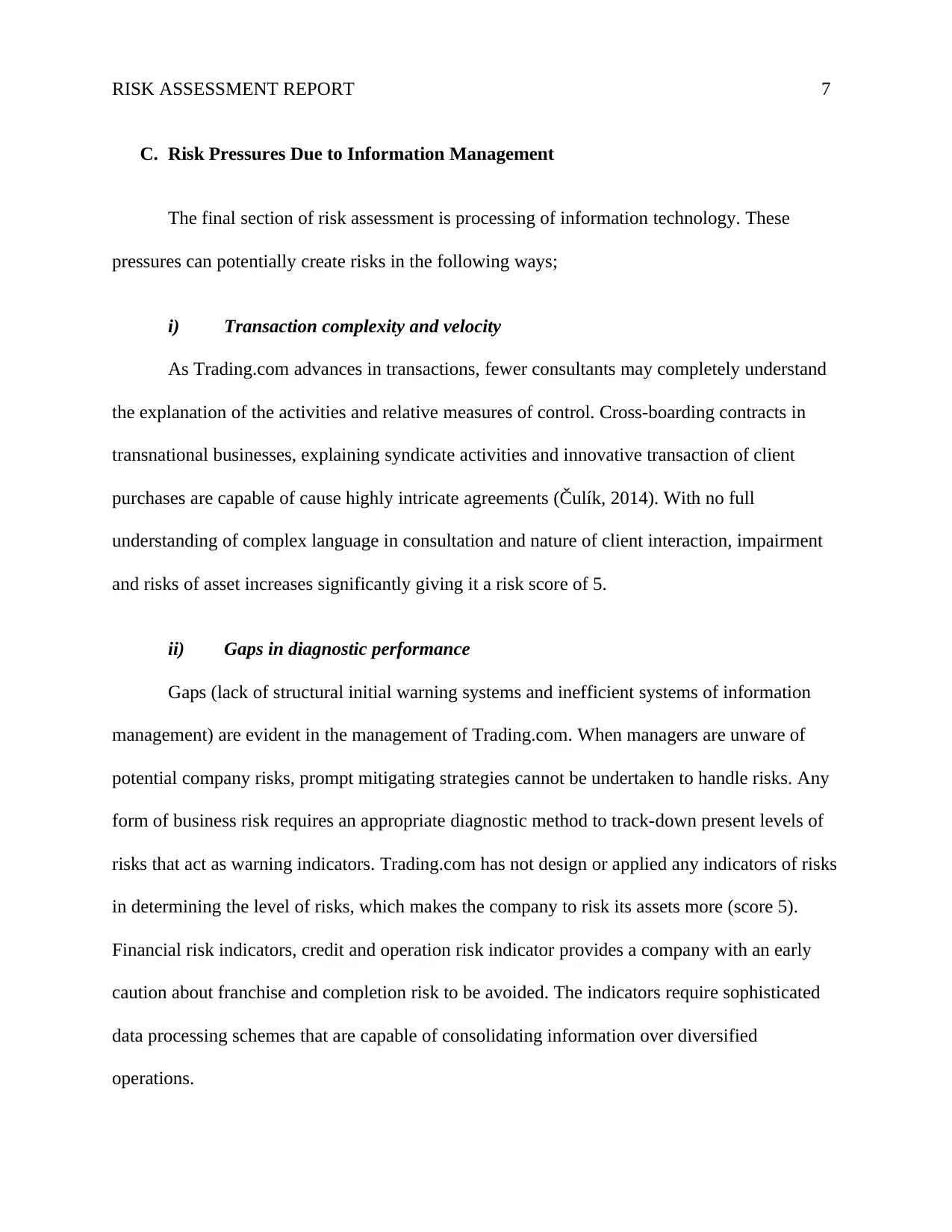
RISK ASSESSMENT REPORT 7
C. Risk Pressures Due to Information Management
The final section of risk assessment is processing of information technology. These
pressures can potentially create risks in the following ways;
i) Transaction complexity and velocity
As Trading.com advances in transactions, fewer consultants may completely understand
the explanation of the activities and relative measures of control. Cross-boarding contracts in
transnational businesses, explaining syndicate activities and innovative transaction of client
purchases are capable of cause highly intricate agreements (Čulík, 2014). With no full
understanding of complex language in consultation and nature of client interaction, impairment
and risks of asset increases significantly giving it a risk score of 5.
ii) Gaps in diagnostic performance
Gaps (lack of structural initial warning systems and inefficient systems of information
management) are evident in the management of Trading.com. When managers are unware of
potential company risks, prompt mitigating strategies cannot be undertaken to handle risks. Any
form of business risk requires an appropriate diagnostic method to track-down present levels of
risks that act as warning indicators. Trading.com has not design or applied any indicators of risks
in determining the level of risks, which makes the company to risk its assets more (score 5).
Financial risk indicators, credit and operation risk indicator provides a company with an early
caution about franchise and completion risk to be avoided. The indicators require sophisticated
data processing schemes that are capable of consolidating information over diversified
operations.
C. Risk Pressures Due to Information Management
The final section of risk assessment is processing of information technology. These
pressures can potentially create risks in the following ways;
i) Transaction complexity and velocity
As Trading.com advances in transactions, fewer consultants may completely understand
the explanation of the activities and relative measures of control. Cross-boarding contracts in
transnational businesses, explaining syndicate activities and innovative transaction of client
purchases are capable of cause highly intricate agreements (Čulík, 2014). With no full
understanding of complex language in consultation and nature of client interaction, impairment
and risks of asset increases significantly giving it a risk score of 5.
ii) Gaps in diagnostic performance
Gaps (lack of structural initial warning systems and inefficient systems of information
management) are evident in the management of Trading.com. When managers are unware of
potential company risks, prompt mitigating strategies cannot be undertaken to handle risks. Any
form of business risk requires an appropriate diagnostic method to track-down present levels of
risks that act as warning indicators. Trading.com has not design or applied any indicators of risks
in determining the level of risks, which makes the company to risk its assets more (score 5).
Financial risk indicators, credit and operation risk indicator provides a company with an early
caution about franchise and completion risk to be avoided. The indicators require sophisticated
data processing schemes that are capable of consolidating information over diversified
operations.
Paraphrase This Document
Need a fresh take? Get an instant paraphrase of this document with our AI Paraphraser
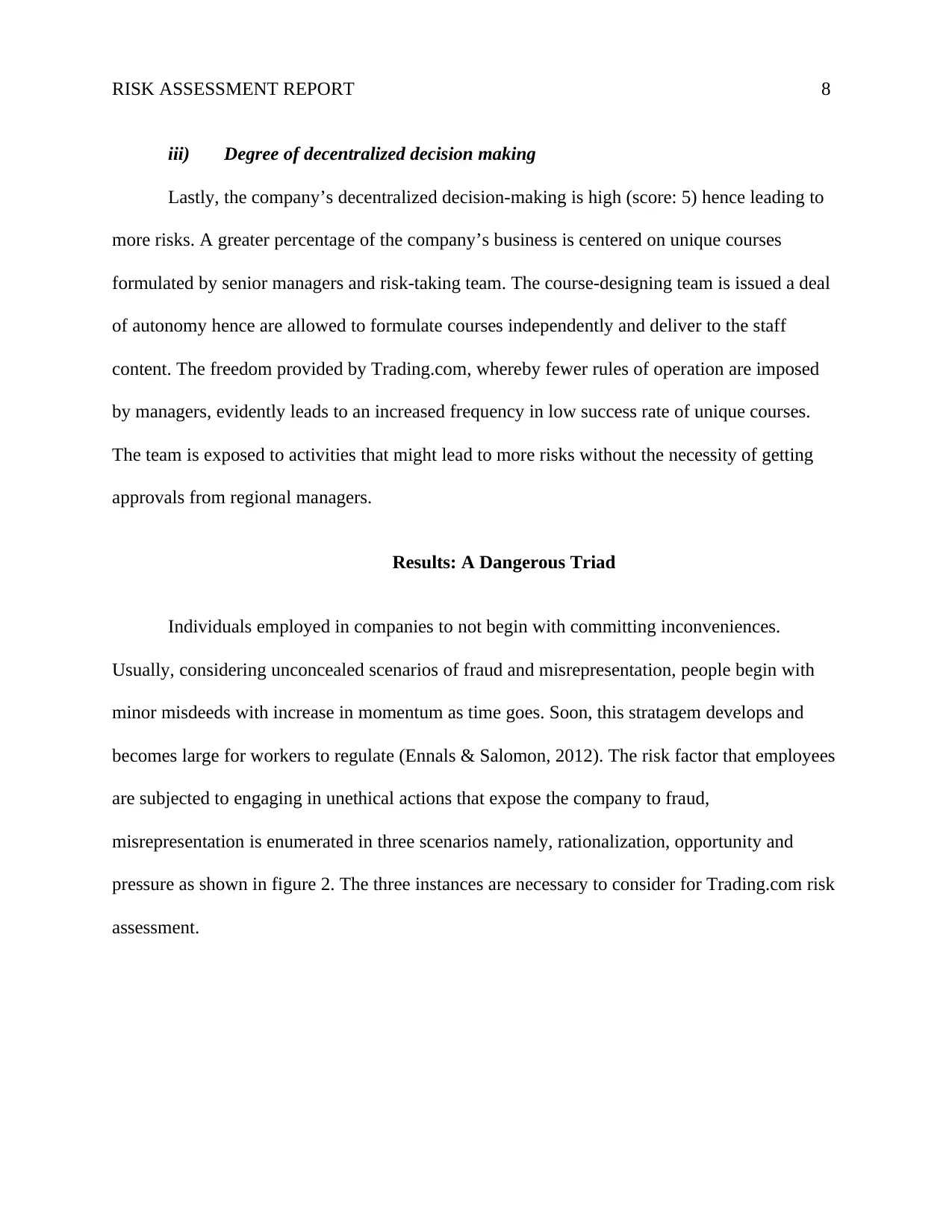
RISK ASSESSMENT REPORT 8
iii) Degree of decentralized decision making
Lastly, the company’s decentralized decision-making is high (score: 5) hence leading to
more risks. A greater percentage of the company’s business is centered on unique courses
formulated by senior managers and risk-taking team. The course-designing team is issued a deal
of autonomy hence are allowed to formulate courses independently and deliver to the staff
content. The freedom provided by Trading.com, whereby fewer rules of operation are imposed
by managers, evidently leads to an increased frequency in low success rate of unique courses.
The team is exposed to activities that might lead to more risks without the necessity of getting
approvals from regional managers.
Results: A Dangerous Triad
Individuals employed in companies to not begin with committing inconveniences.
Usually, considering unconcealed scenarios of fraud and misrepresentation, people begin with
minor misdeeds with increase in momentum as time goes. Soon, this stratagem develops and
becomes large for workers to regulate (Ennals & Salomon, 2012). The risk factor that employees
are subjected to engaging in unethical actions that expose the company to fraud,
misrepresentation is enumerated in three scenarios namely, rationalization, opportunity and
pressure as shown in figure 2. The three instances are necessary to consider for Trading.com risk
assessment.
iii) Degree of decentralized decision making
Lastly, the company’s decentralized decision-making is high (score: 5) hence leading to
more risks. A greater percentage of the company’s business is centered on unique courses
formulated by senior managers and risk-taking team. The course-designing team is issued a deal
of autonomy hence are allowed to formulate courses independently and deliver to the staff
content. The freedom provided by Trading.com, whereby fewer rules of operation are imposed
by managers, evidently leads to an increased frequency in low success rate of unique courses.
The team is exposed to activities that might lead to more risks without the necessity of getting
approvals from regional managers.
Results: A Dangerous Triad
Individuals employed in companies to not begin with committing inconveniences.
Usually, considering unconcealed scenarios of fraud and misrepresentation, people begin with
minor misdeeds with increase in momentum as time goes. Soon, this stratagem develops and
becomes large for workers to regulate (Ennals & Salomon, 2012). The risk factor that employees
are subjected to engaging in unethical actions that expose the company to fraud,
misrepresentation is enumerated in three scenarios namely, rationalization, opportunity and
pressure as shown in figure 2. The three instances are necessary to consider for Trading.com risk
assessment.
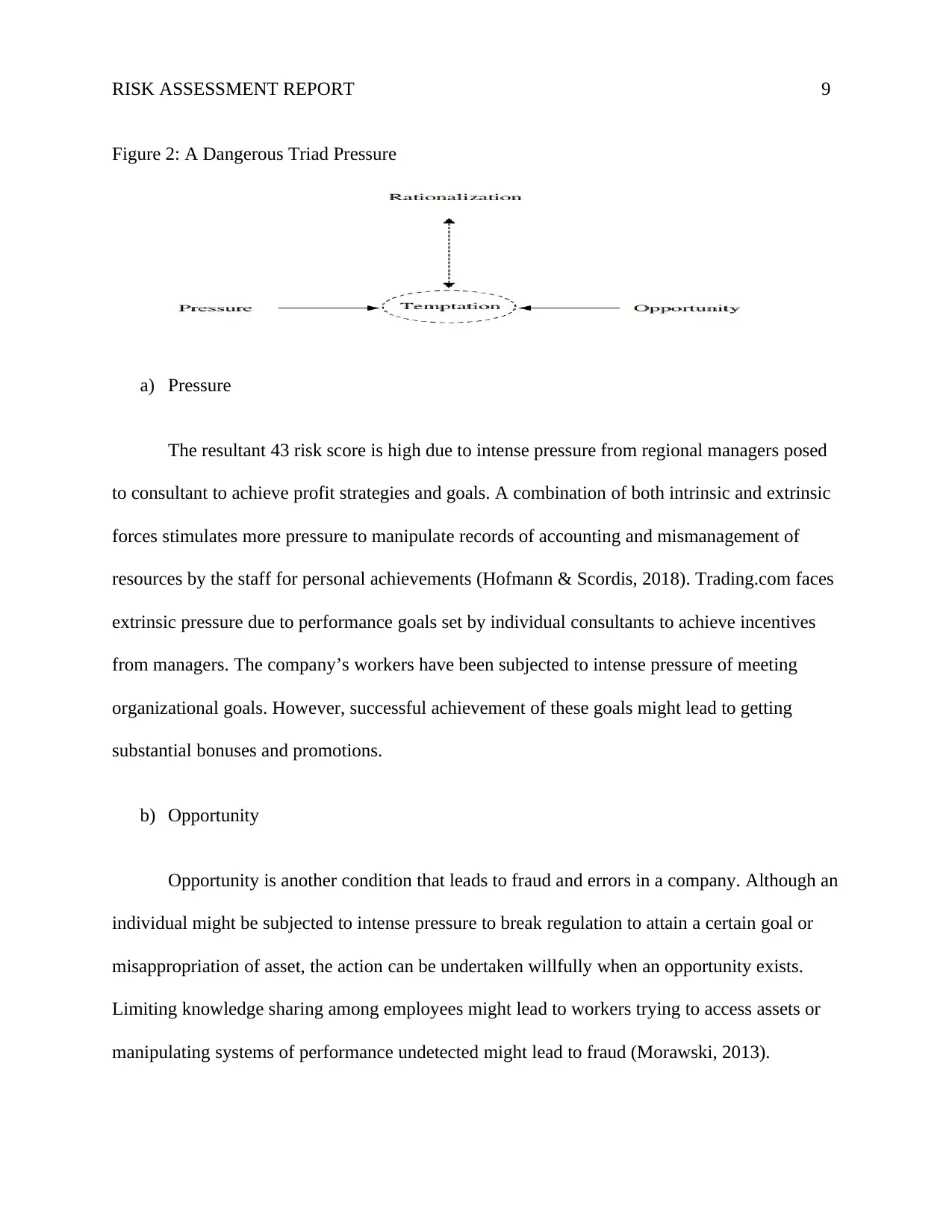
RISK ASSESSMENT REPORT 9
Figure 2: A Dangerous Triad Pressure
a) Pressure
The resultant 43 risk score is high due to intense pressure from regional managers posed
to consultant to achieve profit strategies and goals. A combination of both intrinsic and extrinsic
forces stimulates more pressure to manipulate records of accounting and mismanagement of
resources by the staff for personal achievements (Hofmann & Scordis, 2018). Trading.com faces
extrinsic pressure due to performance goals set by individual consultants to achieve incentives
from managers. The company’s workers have been subjected to intense pressure of meeting
organizational goals. However, successful achievement of these goals might lead to getting
substantial bonuses and promotions.
b) Opportunity
Opportunity is another condition that leads to fraud and errors in a company. Although an
individual might be subjected to intense pressure to break regulation to attain a certain goal or
misappropriation of asset, the action can be undertaken willfully when an opportunity exists.
Limiting knowledge sharing among employees might lead to workers trying to access assets or
manipulating systems of performance undetected might lead to fraud (Morawski, 2013).
Figure 2: A Dangerous Triad Pressure
a) Pressure
The resultant 43 risk score is high due to intense pressure from regional managers posed
to consultant to achieve profit strategies and goals. A combination of both intrinsic and extrinsic
forces stimulates more pressure to manipulate records of accounting and mismanagement of
resources by the staff for personal achievements (Hofmann & Scordis, 2018). Trading.com faces
extrinsic pressure due to performance goals set by individual consultants to achieve incentives
from managers. The company’s workers have been subjected to intense pressure of meeting
organizational goals. However, successful achievement of these goals might lead to getting
substantial bonuses and promotions.
b) Opportunity
Opportunity is another condition that leads to fraud and errors in a company. Although an
individual might be subjected to intense pressure to break regulation to attain a certain goal or
misappropriation of asset, the action can be undertaken willfully when an opportunity exists.
Limiting knowledge sharing among employees might lead to workers trying to access assets or
manipulating systems of performance undetected might lead to fraud (Morawski, 2013).
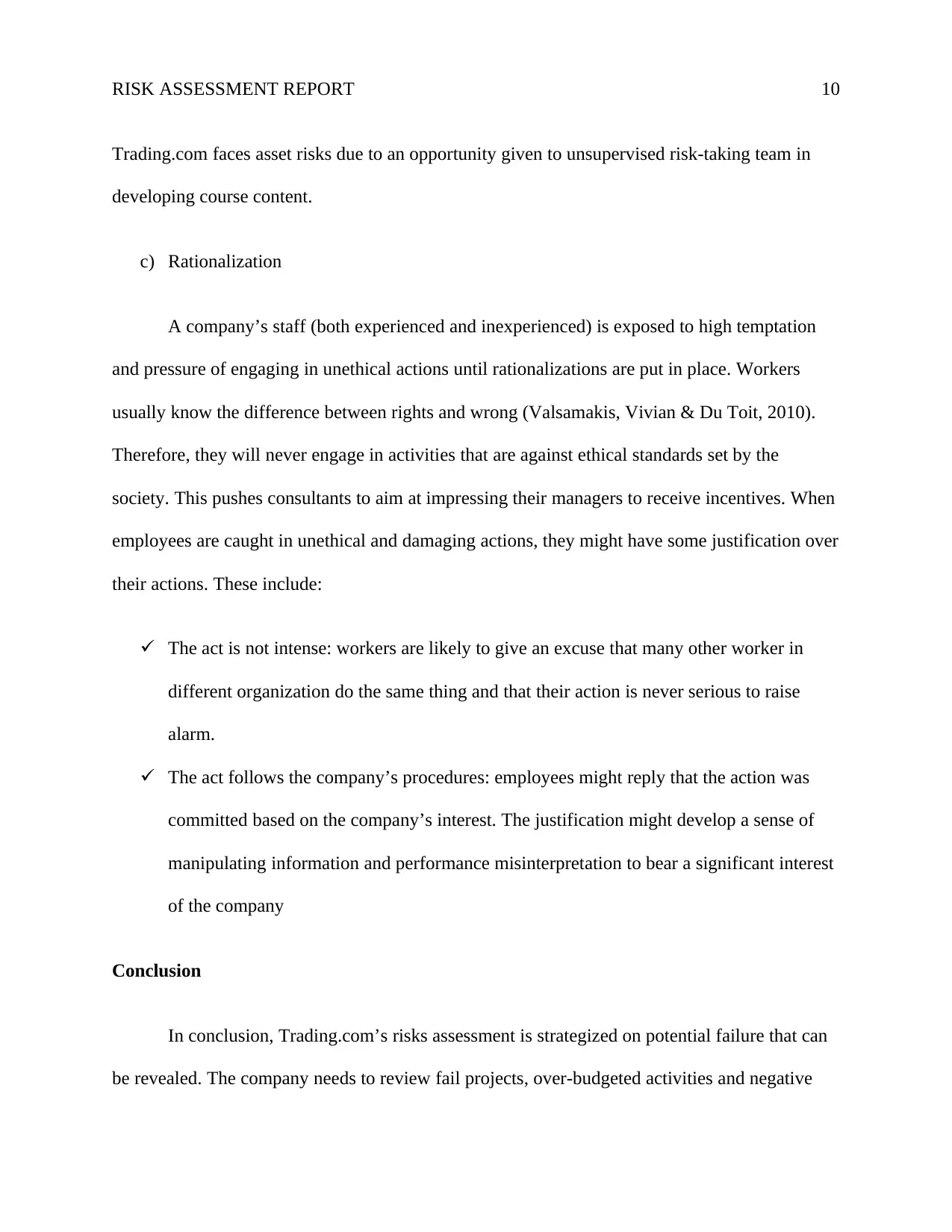
RISK ASSESSMENT REPORT 10
Trading.com faces asset risks due to an opportunity given to unsupervised risk-taking team in
developing course content.
c) Rationalization
A company’s staff (both experienced and inexperienced) is exposed to high temptation
and pressure of engaging in unethical actions until rationalizations are put in place. Workers
usually know the difference between rights and wrong (Valsamakis, Vivian & Du Toit, 2010).
Therefore, they will never engage in activities that are against ethical standards set by the
society. This pushes consultants to aim at impressing their managers to receive incentives. When
employees are caught in unethical and damaging actions, they might have some justification over
their actions. These include:
The act is not intense: workers are likely to give an excuse that many other worker in
different organization do the same thing and that their action is never serious to raise
alarm.
The act follows the company’s procedures: employees might reply that the action was
committed based on the company’s interest. The justification might develop a sense of
manipulating information and performance misinterpretation to bear a significant interest
of the company
Conclusion
In conclusion, Trading.com’s risks assessment is strategized on potential failure that can
be revealed. The company needs to review fail projects, over-budgeted activities and negative
Trading.com faces asset risks due to an opportunity given to unsupervised risk-taking team in
developing course content.
c) Rationalization
A company’s staff (both experienced and inexperienced) is exposed to high temptation
and pressure of engaging in unethical actions until rationalizations are put in place. Workers
usually know the difference between rights and wrong (Valsamakis, Vivian & Du Toit, 2010).
Therefore, they will never engage in activities that are against ethical standards set by the
society. This pushes consultants to aim at impressing their managers to receive incentives. When
employees are caught in unethical and damaging actions, they might have some justification over
their actions. These include:
The act is not intense: workers are likely to give an excuse that many other worker in
different organization do the same thing and that their action is never serious to raise
alarm.
The act follows the company’s procedures: employees might reply that the action was
committed based on the company’s interest. The justification might develop a sense of
manipulating information and performance misinterpretation to bear a significant interest
of the company
Conclusion
In conclusion, Trading.com’s risks assessment is strategized on potential failure that can
be revealed. The company needs to review fail projects, over-budgeted activities and negative
Secure Best Marks with AI Grader
Need help grading? Try our AI Grader for instant feedback on your assignments.
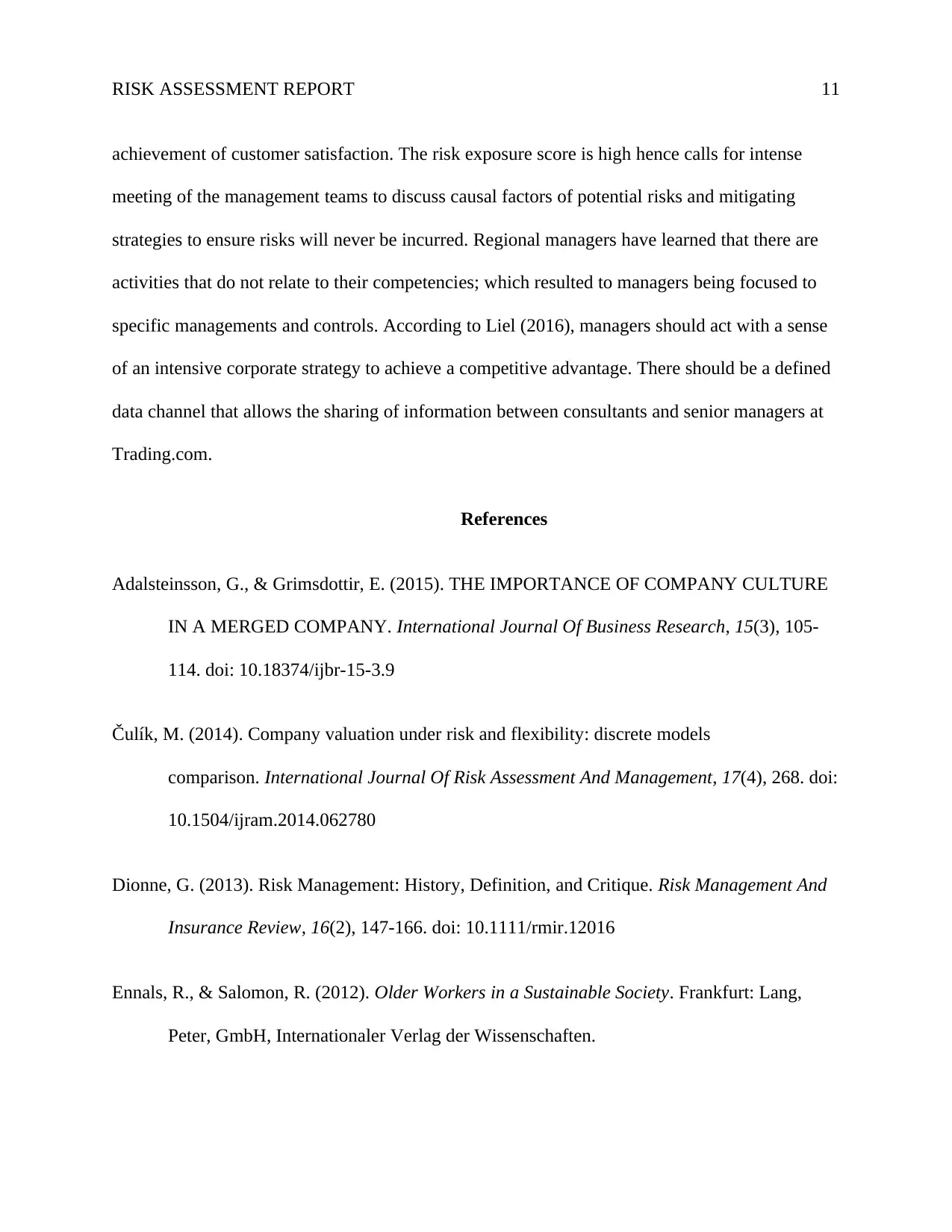
RISK ASSESSMENT REPORT 11
achievement of customer satisfaction. The risk exposure score is high hence calls for intense
meeting of the management teams to discuss causal factors of potential risks and mitigating
strategies to ensure risks will never be incurred. Regional managers have learned that there are
activities that do not relate to their competencies; which resulted to managers being focused to
specific managements and controls. According to Liel (2016), managers should act with a sense
of an intensive corporate strategy to achieve a competitive advantage. There should be a defined
data channel that allows the sharing of information between consultants and senior managers at
Trading.com.
References
Adalsteinsson, G., & Grimsdottir, E. (2015). THE IMPORTANCE OF COMPANY CULTURE
IN A MERGED COMPANY. International Journal Of Business Research, 15(3), 105-
114. doi: 10.18374/ijbr-15-3.9
Čulík, M. (2014). Company valuation under risk and flexibility: discrete models
comparison. International Journal Of Risk Assessment And Management, 17(4), 268. doi:
10.1504/ijram.2014.062780
Dionne, G. (2013). Risk Management: History, Definition, and Critique. Risk Management And
Insurance Review, 16(2), 147-166. doi: 10.1111/rmir.12016
Ennals, R., & Salomon, R. (2012). Older Workers in a Sustainable Society. Frankfurt: Lang,
Peter, GmbH, Internationaler Verlag der Wissenschaften.
achievement of customer satisfaction. The risk exposure score is high hence calls for intense
meeting of the management teams to discuss causal factors of potential risks and mitigating
strategies to ensure risks will never be incurred. Regional managers have learned that there are
activities that do not relate to their competencies; which resulted to managers being focused to
specific managements and controls. According to Liel (2016), managers should act with a sense
of an intensive corporate strategy to achieve a competitive advantage. There should be a defined
data channel that allows the sharing of information between consultants and senior managers at
Trading.com.
References
Adalsteinsson, G., & Grimsdottir, E. (2015). THE IMPORTANCE OF COMPANY CULTURE
IN A MERGED COMPANY. International Journal Of Business Research, 15(3), 105-
114. doi: 10.18374/ijbr-15-3.9
Čulík, M. (2014). Company valuation under risk and flexibility: discrete models
comparison. International Journal Of Risk Assessment And Management, 17(4), 268. doi:
10.1504/ijram.2014.062780
Dionne, G. (2013). Risk Management: History, Definition, and Critique. Risk Management And
Insurance Review, 16(2), 147-166. doi: 10.1111/rmir.12016
Ennals, R., & Salomon, R. (2012). Older Workers in a Sustainable Society. Frankfurt: Lang,
Peter, GmbH, Internationaler Verlag der Wissenschaften.
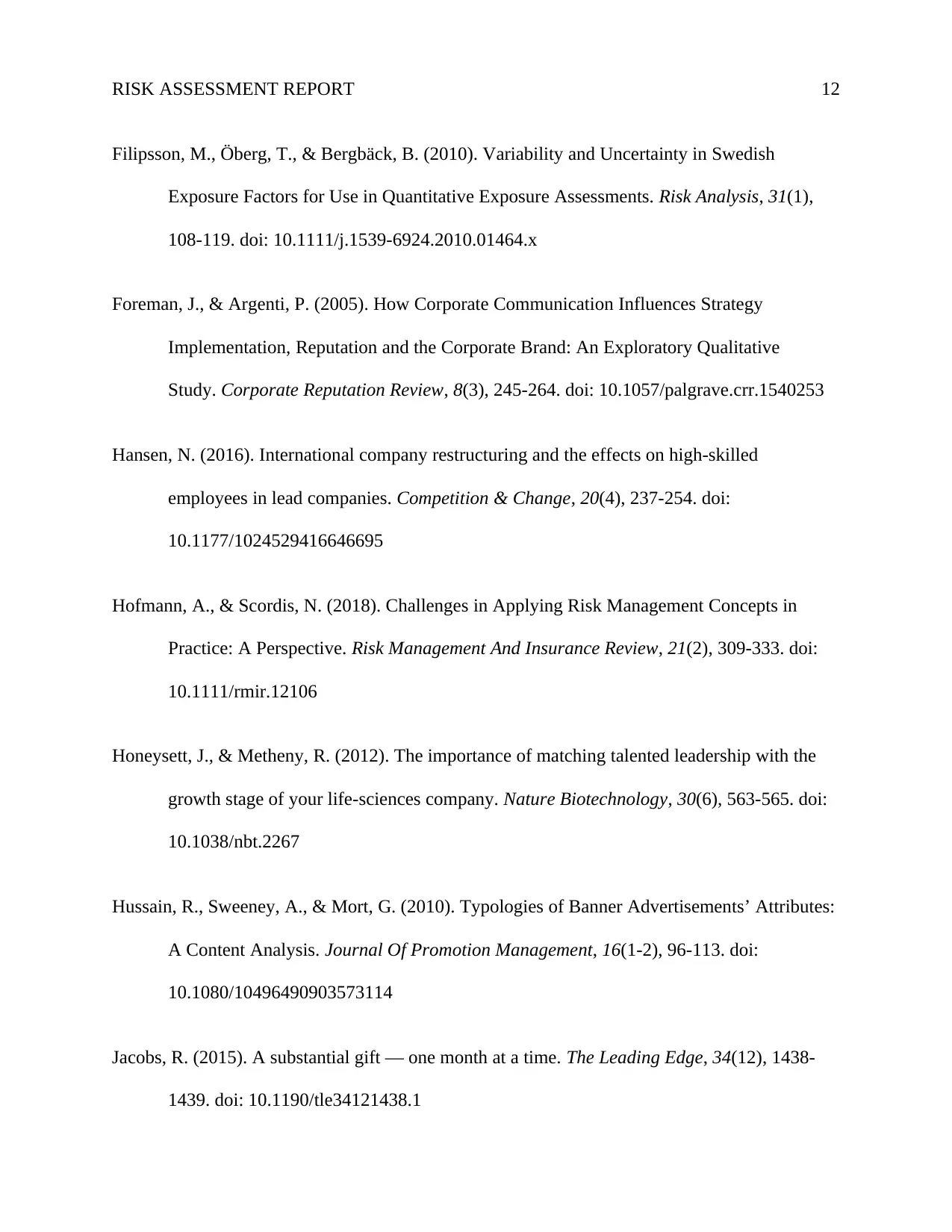
RISK ASSESSMENT REPORT 12
Filipsson, M., Öberg, T., & Bergbäck, B. (2010). Variability and Uncertainty in Swedish
Exposure Factors for Use in Quantitative Exposure Assessments. Risk Analysis, 31(1),
108-119. doi: 10.1111/j.1539-6924.2010.01464.x
Foreman, J., & Argenti, P. (2005). How Corporate Communication Influences Strategy
Implementation, Reputation and the Corporate Brand: An Exploratory Qualitative
Study. Corporate Reputation Review, 8(3), 245-264. doi: 10.1057/palgrave.crr.1540253
Hansen, N. (2016). International company restructuring and the effects on high-skilled
employees in lead companies. Competition & Change, 20(4), 237-254. doi:
10.1177/1024529416646695
Hofmann, A., & Scordis, N. (2018). Challenges in Applying Risk Management Concepts in
Practice: A Perspective. Risk Management And Insurance Review, 21(2), 309-333. doi:
10.1111/rmir.12106
Honeysett, J., & Metheny, R. (2012). The importance of matching talented leadership with the
growth stage of your life-sciences company. Nature Biotechnology, 30(6), 563-565. doi:
10.1038/nbt.2267
Hussain, R., Sweeney, A., & Mort, G. (2010). Typologies of Banner Advertisements’ Attributes:
A Content Analysis. Journal Of Promotion Management, 16(1-2), 96-113. doi:
10.1080/10496490903573114
Jacobs, R. (2015). A substantial gift — one month at a time. The Leading Edge, 34(12), 1438-
1439. doi: 10.1190/tle34121438.1
Filipsson, M., Öberg, T., & Bergbäck, B. (2010). Variability and Uncertainty in Swedish
Exposure Factors for Use in Quantitative Exposure Assessments. Risk Analysis, 31(1),
108-119. doi: 10.1111/j.1539-6924.2010.01464.x
Foreman, J., & Argenti, P. (2005). How Corporate Communication Influences Strategy
Implementation, Reputation and the Corporate Brand: An Exploratory Qualitative
Study. Corporate Reputation Review, 8(3), 245-264. doi: 10.1057/palgrave.crr.1540253
Hansen, N. (2016). International company restructuring and the effects on high-skilled
employees in lead companies. Competition & Change, 20(4), 237-254. doi:
10.1177/1024529416646695
Hofmann, A., & Scordis, N. (2018). Challenges in Applying Risk Management Concepts in
Practice: A Perspective. Risk Management And Insurance Review, 21(2), 309-333. doi:
10.1111/rmir.12106
Honeysett, J., & Metheny, R. (2012). The importance of matching talented leadership with the
growth stage of your life-sciences company. Nature Biotechnology, 30(6), 563-565. doi:
10.1038/nbt.2267
Hussain, R., Sweeney, A., & Mort, G. (2010). Typologies of Banner Advertisements’ Attributes:
A Content Analysis. Journal Of Promotion Management, 16(1-2), 96-113. doi:
10.1080/10496490903573114
Jacobs, R. (2015). A substantial gift — one month at a time. The Leading Edge, 34(12), 1438-
1439. doi: 10.1190/tle34121438.1
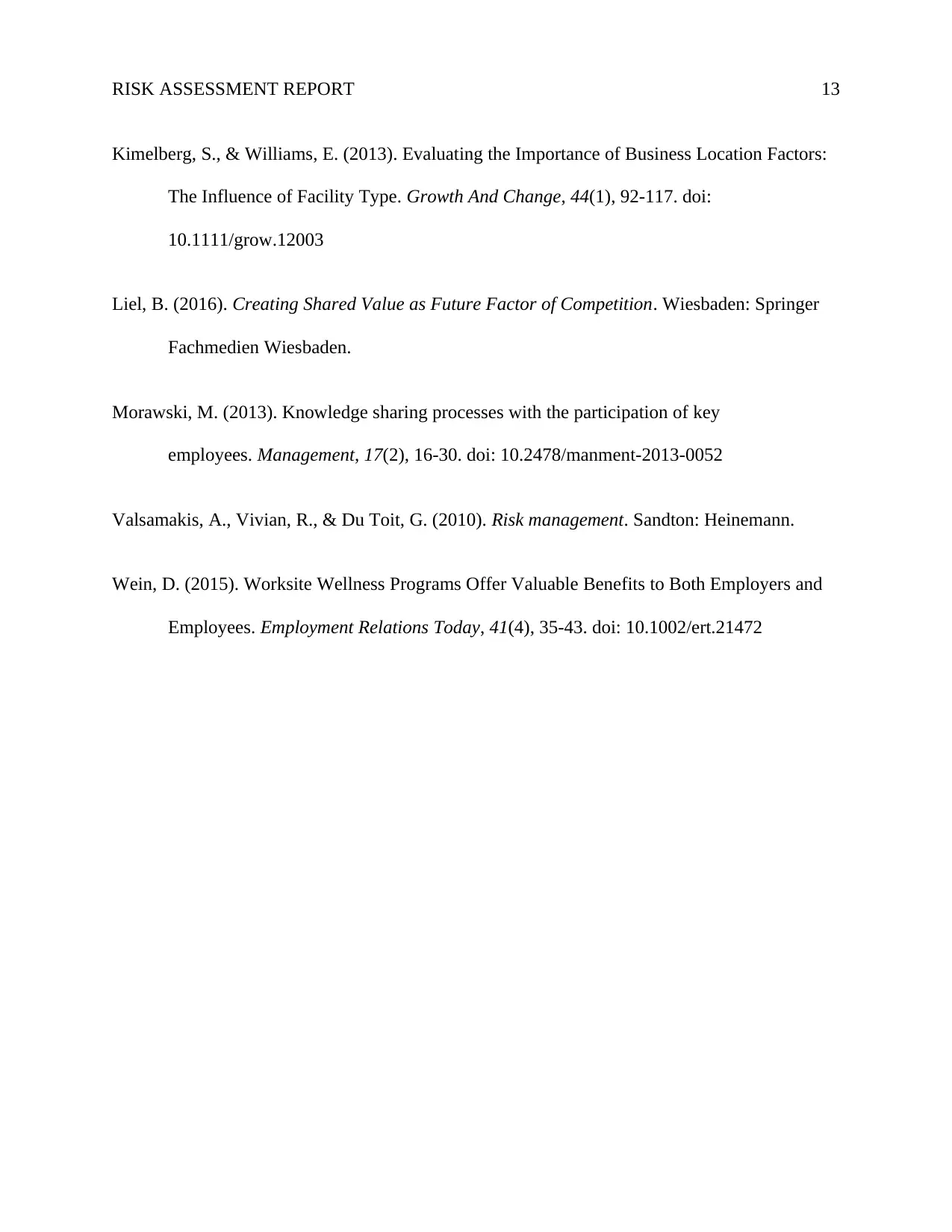
RISK ASSESSMENT REPORT 13
Kimelberg, S., & Williams, E. (2013). Evaluating the Importance of Business Location Factors:
The Influence of Facility Type. Growth And Change, 44(1), 92-117. doi:
10.1111/grow.12003
Liel, B. (2016). Creating Shared Value as Future Factor of Competition. Wiesbaden: Springer
Fachmedien Wiesbaden.
Morawski, M. (2013). Knowledge sharing processes with the participation of key
employees. Management, 17(2), 16-30. doi: 10.2478/manment-2013-0052
Valsamakis, A., Vivian, R., & Du Toit, G. (2010). Risk management. Sandton: Heinemann.
Wein, D. (2015). Worksite Wellness Programs Offer Valuable Benefits to Both Employers and
Employees. Employment Relations Today, 41(4), 35-43. doi: 10.1002/ert.21472
Kimelberg, S., & Williams, E. (2013). Evaluating the Importance of Business Location Factors:
The Influence of Facility Type. Growth And Change, 44(1), 92-117. doi:
10.1111/grow.12003
Liel, B. (2016). Creating Shared Value as Future Factor of Competition. Wiesbaden: Springer
Fachmedien Wiesbaden.
Morawski, M. (2013). Knowledge sharing processes with the participation of key
employees. Management, 17(2), 16-30. doi: 10.2478/manment-2013-0052
Valsamakis, A., Vivian, R., & Du Toit, G. (2010). Risk management. Sandton: Heinemann.
Wein, D. (2015). Worksite Wellness Programs Offer Valuable Benefits to Both Employers and
Employees. Employment Relations Today, 41(4), 35-43. doi: 10.1002/ert.21472
1 out of 13
Related Documents
Your All-in-One AI-Powered Toolkit for Academic Success.
+13062052269
info@desklib.com
Available 24*7 on WhatsApp / Email
![[object Object]](/_next/static/media/star-bottom.7253800d.svg)
Unlock your academic potential
© 2024 | Zucol Services PVT LTD | All rights reserved.




